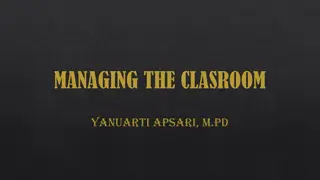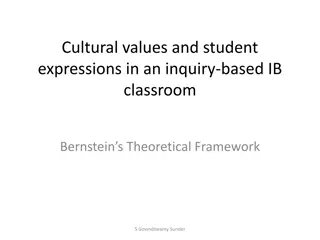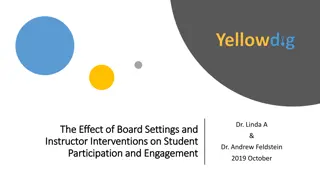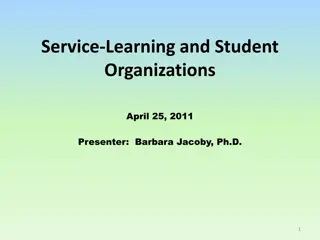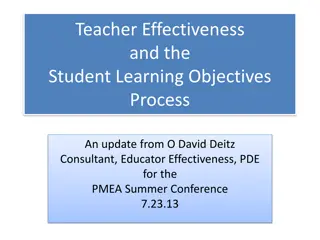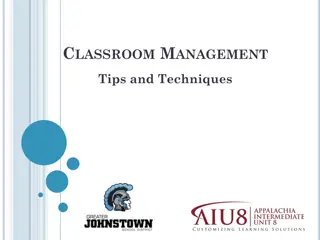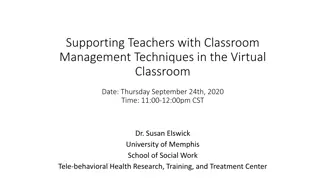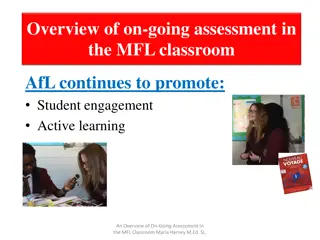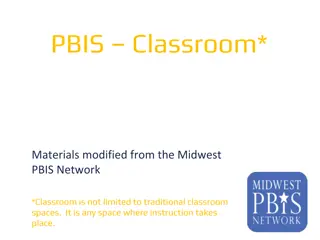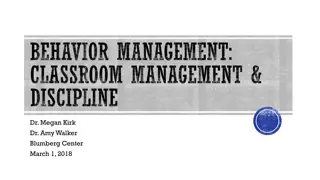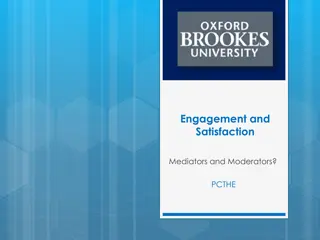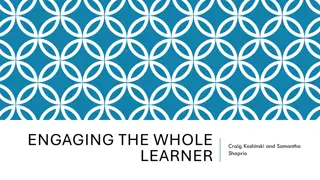Impact of Classroom Design on Student Engagement and Learning in High School Settings
A study conducted in Milano in 2016 investigated the effects of different work surfaces in high school classrooms on student engagement and behaviors. Students were assigned to various surfaces like whiteboards, blackboards, and notebooks, leading to changes in their participation, collaboration, and enthusiasm for learning mathematics. The findings suggest that classroom design influences students' interactions and engagement levels, with visually random groups proving beneficial for promoting collaboration and problem-solving skills.
Download Presentation

Please find below an Image/Link to download the presentation.
The content on the website is provided AS IS for your information and personal use only. It may not be sold, licensed, or shared on other websites without obtaining consent from the author.If you encounter any issues during the download, it is possible that the publisher has removed the file from their server.
You are allowed to download the files provided on this website for personal or commercial use, subject to the condition that they are used lawfully. All files are the property of their respective owners.
The content on the website is provided AS IS for your information and personal use only. It may not be sold, licensed, or shared on other websites without obtaining consent from the author.
E N D
Presentation Transcript
Milano 2016 POLITECNICO di MILANO PhD COURSE day 1
Milano 2016 EMPIRICAL RESULTS
Milano 2016 VERTICAL NON-PERMANENT SURFACES
Milano 2016 five high school classrooms two grade 12 (n=31, 30) two grade 11 (n=32, 31) one grade 10 (n=31) students were put into groups of two to four assigned to one of five work surfaces vertical non-permanent surface (whiteboard, blackboard) horizontal non-permanent surface (whiteboard) vertical permanent surface (flipchart paper) horizontal permanent surface (flipchart paper) notebook EFFECT ON STUDENTS
Milano 2016 PROXIES FOR ENGAGEMENT time to task time to first mathematical notation amount of discussion eagerness to start participation persistence knowledge mobility non-linearity of work 0 - 3 EFFECT ON STUDENTS
Milano 2016 vertical non-perm 10 12.8 sec 20.3 sec 2.8 3.0 2.8 2.6 2.5 2.7 horizontal non-perm 10 13.2 sec 23.5 sec 2.2 2.3 2.3 2.6 1.2 2.9 vertical permanent 9 12.1 sec 2.4 min 1.5 1.2 1.8 1.8 2.0 1.0 horizontal permanent 9 14.1 sec 2.1 min 1.1 1.0 1.6 1.9 1.3 1.1 notebook N (groups) time to task first notation discussion eagerness participation persistence mobility non-linearity 8 13.0 sec 18.2 sec 0.6 0.9 0.9 1.9 1.2 0.8 Liljedahl, P. (in press). Building thinking classrooms: Conditions for problem solving. In P. Felmer, J. Kilpatrick, & E. Pekhonen (eds.) Posing and Solving Mathematical Problems: Advances and New Perspectives. New York, NY: Springer. EFFECT ON STUDENTS
Milano 2016 VISIBLY RANDOM GROUPS
Milano 2016 grade 10 90% Asian or Caucasian February April (linear system Sept - June) field notes observations interactions conversations interviews teacher students EFFECT ON STUDENTS
Milano 2016 students become agreeable to work in any group they are placed in there is an elimination of social barriers within the classroom mobility of knowledge between students increases reliance on co-constructed intra- and inter-group answers increases reliance on the teacher for answers decreases engagement in classroom tasks increase students become more enthusiastic about mathematics class Liljedahl, P. (in press). The affordances of using visually random groups in a mathematics classroom. In Y. Li, E. Silver, & S. Li (eds.) Transforming Mathematics Instruction: Multiple Approaches and Practices. New York, NY: Springer. EFFECT ON STUDENTS
Milano 2016 THEORIES
Milano 2016 It seems reasonable that the practice of teaching mathematics can and should draw on our depth of knowledge of mathematical learning, and learning theory, but to theorise teaching is a problem with which most educators are struggling. While theory provides us with lenses for analysing learning, the big theories do not seem to offer clear insights to teaching and ways in which teaching addresses the promotion of mathematics learning. Jaworski (2006) BUT ARE THESE THEORIES?
Milano 2016 Theories help us to analyse, or explain, but they do not provide recipes for action; rarely do they provide direct guidance for practice. We can analyse or explain mathematics learning perspectives, but it is naive to assume or postulate theoretically derivative models or methods through which learning is supposed to happen. from theoretical Jaworski (2006) BUT ARE THESE THEORIES?
Milano 2016 Theories help us to analyse, or explain, but they do not provide recipes for action; rarely do they provide direct guidance for practice. We can analyse or explain mathematics learning perspectives, but it is naive to assume or postulate theoretically derivative models or methods through which learning is supposed to happen. from theoretical Jaworski (2006) there are NO theories of teaching! BUT ARE THESE THEORIES?
Milano 2016 a theory needs to be: (a) substantiated (b) explanatory (c) predictive (d) testable THEORIES
Milano 2016 a belief, policy, or procedure proposed or followed as the basis of action <her method is based on the theory that all children want to learn> (Merriam-Webster, online edition, 2016) a system of rules, procedures, and assumptions us ed to produce a result (Collins English Dictionary Complete and Unabridged, 12th Edition, 2014) a belief or principle that guides action or assists co mprehension or judgment (American Heritage Dictionary of the English Language, Fifth Edition, 2011) THEORIES
Milano 2016 THEORY OF LEARNING vs. THEORY FOR TEACHING THEORY OF vs. THEORY FOR
Milano 2016 a theory of needs to be: (a) substantiated (b) explanatory (c) predictive (d) testable a theory for needs to be: (a) ? (b) ? (c) ? (d) ? THEORY OF vs. THEORY FOR
Milano 2016 POSSIBLE WORKSHOP OUTCOMES: 1.enjoy the learning experience 2.learn some things about teaching 3.convert a theory of learning into a theory for teaching 4.extract a theory for teaching from empirical work 5.define requirements of a theory for teaching WORKSHOP EXPECTATION: you will achieve at least two of the above outcomes quick and dirty presentation on Wednesday afternoon DIVERSE WORKSHOP OUTCOMES


